“The Link Between Infections and Deaths Has Been Broken”
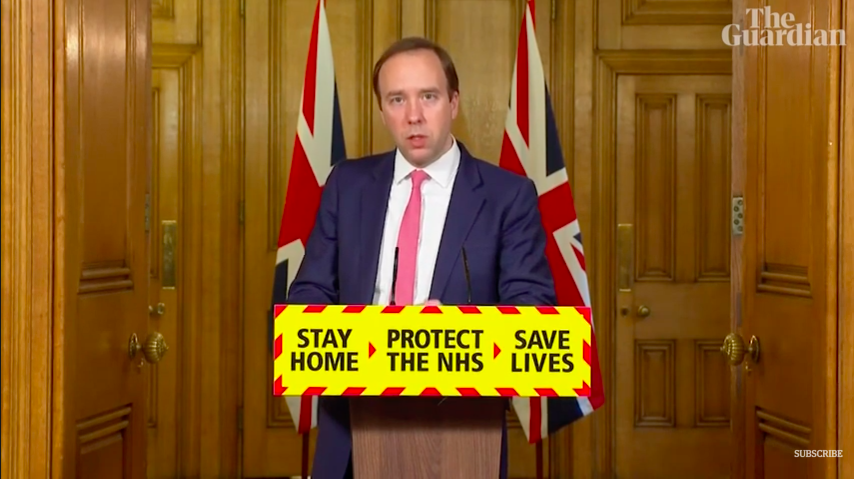
Health Secretary Matt Hancock struck an upbeat tone at the daily press conference yesterday where he announced that a single dose of either the AstraZenica or Pfizer jab reduces risk of hospitalisation in the over-80s by 80%. He continued:
The effectiveness of the vaccine on protecting people, and on reducing transmission, is critical to the roadmap [for lifting lockdown restrictions]… The data that we’ve published today shows that the roadmap is achievable, because it shows that we will be able to break the link from cases through to hospitalisations and to deaths, and until now in the pandemic that link from cases through to hospitalisations and deaths has been unbreakable. And we have demonstrated with the data today that the vaccines can break that link, and that is down to the power of science. So it’s good news for everybody.
Good, but given that all the over-80s and all the over-70s have now been offered at least one dose – and more than 90% have taken that offer – why is there so little urgency in when it comes to lifting of restrictions, considering what a whopping chunk of Covid hospitalisations and deaths these people account for?
Meanwhile, a ‘manhunt’ is underway for a missing case of the so-called Brazilian variant. Prime Minister Boris Johnson downplayed fears about the variant though, saying:
We have no reason not to think our vaccines are effective against these variants of concern. People should take that as some evidence of confidence.
Health Correspondent Nick Triggle at the BBC had this analysis.
It is tempting to think that if officials can identify the one missing case, the UK will be able to stamp out the Brazil variant.
But it’s unlikely this will be possible. There will no doubt be more cases either of this variant or others circulating with the E484 mutation that allows the virus to escape some of the effect of the vaccines.
That’s because not all positive cases can be checked for variants. The UK carries out nearly half of the genomic sequencing in the world and can check around 25,000 positive tests a week for variants.
That means about a quarter of positive cases were checked last week, but a month ago – with infection rates higher – it was under one in 10.
What is more, not everyone who is positive comes forward for a test in the first place. We are seeing just the top of the iceberg.
We received this intriguing comment about the variants from a well-connected reader who cannot be named lest he endanger his source.
I have good reason to believe that Hancock is desperate for variants, and that experts think it a waste of time to hunt for them and think vaccinations are fine to keep things going well, including coping with variants. He wants twice daily briefings on any possible variants.
Stop Press: How to spot the Brazilian variant.
Battle-Weary Peter Hitchens Takes Flak for Jab Decision
Peter Hitchens, one of the earliest of the UK’s small band of sceptical journalists, used his weekly conversation with Mike Graham on talkRADIO to discuss the mixed reaction to his Mail on Sunday column in which he revealed he had had his first Covid jab. He wrote:
Of course my selfish injection didn’t hurt. I’m a blood donor (so also please don’t call me selfish), used to far bigger needles in my arm, for a lot longer. I did feel a pang of regret and loss. For me, the vaccination was a gloomy submission to a new world of excessive safety and regulation. I’d tried to fight against it but I lost.
The New Jerusalem, in which we allow the state to boss us around even more, in the name of our own good, is now coming into being.
And so we are just going to be under surveillance a lot more, recorded a lot more and bossed about a lot more.
He had weighed up the pros and cons and concluded that, nearing 70 and with part of his family abroad who he had been prevented from seeing for over a year, resisting the coming vaccine passport system was un-winnable. In response, he was deluged with accusations of capitulation on social media yesterday. Anyone who has listened much to Hitchens for the last year will know that he has said very little about the vaccine and certainly never said whether he would or wouldn’t take it, nor discouraged anyone else from taking it. On talkRADIO, he underlined the point that the battle was over as far as he was concerned.
You can’t lead when there’s nothing much behind you. I’ve worked day and night, before breakfast, before lunch, before supper, into the evening day after day after day trying to make the case against this folly for 11 long months, sometimes very nearly totally alone in my trade. I resent very much anyone who suggests that I didn’t put my all into it or that I didn’t believe in it. But I don’t think that there has been sufficient resistance at a time when it could have been any use. People wake up now and say, “Oh gosh, this is all a terrible mistake!” – Where were they?! – Particularly in my own trade, but in general, where were they in the months of March, April and June? Where were they in Parliament, in the Law, when some difference could have been made and this could have been stopped? They weren’t anywhere to be seen. It’s no good turning on me now and saying ,”Actually, we have failed.” I didn’t fail! I kept on, but I’m just not going to pretend you can carry on and on fighting a battle with nobody behind you against an enormously powerful, immensely rich enemy who simply turns a steamroller on you. I’ve been steamrollered. It’s an experience I’m horribly used to.
He turned his exasperation on would-be members of the ‘resistance’ who remained silent.
There are people in this country not like me, a lot of people I just don’t appeal to, but commentators who instantly, if they take up a cause, attract a powerful following, and I’d name two of those among them. Douglas Murray and Charles (now Lord) Moore. These were voices which in my view, if they’d spoken out against this, could have changed the whole tendency of things. But among so many others, they looked on it as spectators. They didn’t see it as their cause.
Perhaps it is a sign that Hitchens is going to hang up his fiddle, but we certainly hope not.
Worth watching in full.
Hypocrite of the Week
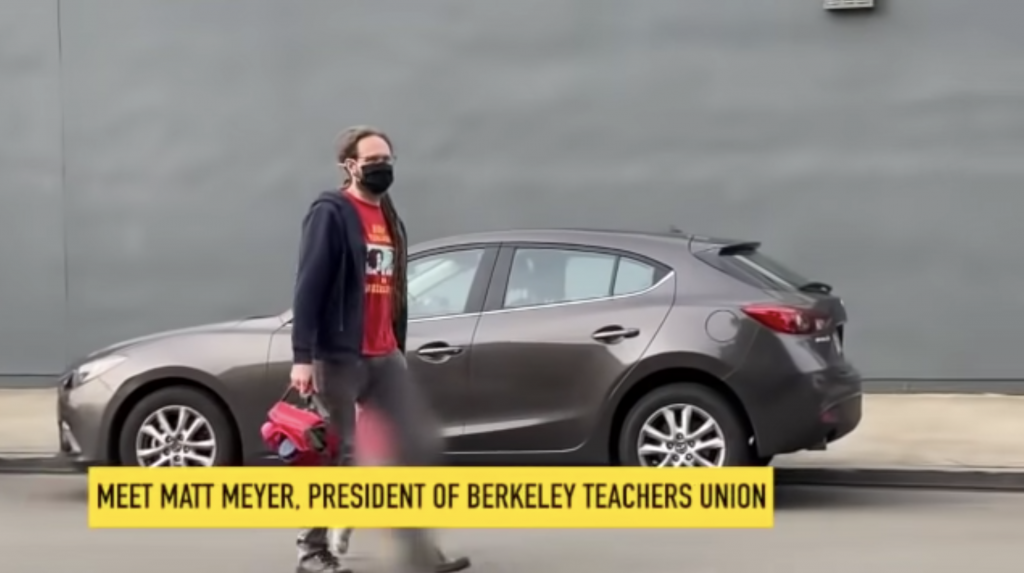
We thought our teaching unions were bad, but America’s are worse. The President of a teaching federation in California, who’s been campaigning against re-opening public schools, was spotted dropping his own child off at a private school. Fox News has more.
A group known as Guerilla Momz is calling Berkeley Federation of Teachers president Matt Meyer a hypocrite after spotting him dropping his two-year-old daughter off for in-person instruction at a private pre-school.
“Meet Matt Meyer. White man with dreads and president of the local teachers’ union,” the group wrote in a tweet on Saturday along with video footage of Meyer. “He’s been saying it is unsafe for *your kid* to be back at school, all the while dropping his kid off at private school.”
Meyer told Fox News in a statement that the video, which blurred out his child’s face, was “very inappropriate” and an intrusion of his child’s privacy. He added that there were “no public options for kids her age”.
As ever, it’s one rule for me and another for thee.
Worth reading in full.
Stop Press 2: An editorial has been published in the British Medical Journal by Sarah J. Lewis, Alasdair P.S. Munro, George Davey Smith, and Allyson M. Pollock entitled “Closing schools is not evidence-based and harms children“.
Keeping schools open should be the UK’s top priority
Some 8.8 million schoolchildren in the UK have experienced severe disruption to their education, with prolonged school closures and national exams cancelled for two consecutive years. School closures have been implemented internationally with insufficient evidence for their role in minimising COVID-19 transmission and insufficient consideration of the harms to children.
For some children education is their only way out of poverty; for others school offers a safe haven away from a dangerous or chaotic home life. Learning loss, reduced social interaction, isolation, reduced physical activity, increased mental health problems, and potential for increased abuse, exploitation, and neglect have all been associated with school closures. Reduced future income and life expectancy are associated with less education. Children with special educational needs or who are already disadvantaged are at increased risk of harm. The 2019 report of the Children’s Commissioner for England estimated that 2.3 million children in England were living in unsafe home environments with domestic violence, drug or alcohol abuse, or severe mental problems among parents. These long term harms are likely to be magnified by further school closures.
The overall risk to children and young people from COVID-19 is very small, and hyperinflammatory syndrome is extremely rare. Studies are under way to gauge the effect of post-Covid syndrome among children.
Although school closures reduce the number of contacts children have, and may decrease transmission, a study of 12 million adults in the UK found no difference in the risk of death from COVID-19 in households with or without children. Only 3% of people aged over-65 live with children.
In-person learning increases teachers’ exposure and might be expected to increase their risk of becoming infected, but accumulating evidence shows that teachers and school staff are not at higher risk of hospital admission or death from COVID-19 compared with other workers. Teacher absence because of confirmed COVID-19 in England was similar in primary and secondary schools in the autumn term, despite secondary schoolchildren having much higher rates of SARS-CoV-2 infection. Moreover teacher absence decreased in Tier 3 regions during the November lockdown despite schools remaining open.
Worth reading in full.
Hans Rosling’s Ten Instincts

A reader has got in touch with a summary of the 10 faulty human instincts described in Hans Rosling’s book Factfulness, lifted from a review of the book on Amazon. The question is: How many of these faults has the Government exhibited in its thinking about the pandemic?
1. The Gap Instinct – We tend to divide the things into two distinct groups and imagine a gap between them. To control gap instinct, look for the majority. Beware of the averages, if you look at the spread, the majority will overlap. Beware comparisons of extremes (the media loves to do it).
2. The Negativity Instinct – We tend to instinctively notice the bad more than the good. We need to learn to acknowledge the fact that things can be both ‘better’ and ‘bad’ at the same time. Example, education levels have improved over time, but still, 10% of the children don’t get any education, that’s bad. We also need to know that good news is never reported, media would hype the bad stuff always. Subsequently, gradual improvement isn’t reported either. Countries, government, media often try to glorify the past, so we need to be beware of these rosy pasts.
3. The Straight Line Instinct – When we see a line going up steadily, we tend to assume the line will continue to go up in the foreseeable future. To control this instinct, remember that curves come in different shapes. Finally, don’t assume straight lines if data doesn’t show it.
4. The Fear Instinct – We tend to perceive the world to be scarier than it really is. We overestimate the risks associated with violence, captivity, contamination, etc. The world seems scarier because what you hear has been carefully selected to be told. Remember, Risk = Danger x Exposure, and act accordingly. Make decisions only when you’re calm, not when you are afraid.
5. The Size Instinct – We tend to see things out of proportion, over-estimating the importance of a single event/person that’s visible to us, and the scale of an issue based on a standalone number. A lonely number may seem impressive in isolation, but can be trivial in comparison to something else. Hence, always look for comparisons. Use the 80/20 rule. When comparing countries, look for rates per person.
6. The Generalisation Instinct – We tend to wrongly assume that everything or everyone in a category is similar. Hence, we must look for differences within a group, look for similarities across groups and look for differences across groups. We should beware of the term ‘Majority’ – it can mean 51% or 99% or anything in between. Beware of vivid images, which are easier to recall but can be exceptions to the general norm.
7. The Destiny Instinct – We tend to assume that the destinies of people, cultures, countries, etc. are predetermined by certain factors, and such factors are fixed and unchanging, i.e., their destinies are fixed. To control this, we must keep track of gradual changes and improvements. We should update our knowledge on different subjects, and look for examples of cultural changes.
8. The Single Perspective Instinct – We tend to focus on single causes or solutions, which are easier to grasp and make our problems seem easier to solve. It is better to look at problems from multiple perspectives. To control this, always test your ideas and allow people to find weaknesses. Don’t claim to be an expert at all times, be humble about your limited expertise in different areas.
9. The Blame Instinct – When something goes wrong, we instinctively blame it on someone or something. To control this, resist finding a scapegoat. Look for causes, not villains. Finally, look for systems and processes, not heroes.
10. The Urgency Instinct – We tend to rush into a problem or opportunity for fear that there’s no time and we may be too late. To control this, take small steps. Always insist on data rather than making hunch based hasty decisions. Always be aware of the side effects of your hasty decision to avoid making the same.
The Mortality Risk of COVID-19 is Dying Out
We are publishing an original paper today by Howard Greene that looks at the diminishing risk of dying from COVID-19 and argues that it’s now within the normal range Americans are typically prepared to live with and, for that reasons, restrictions should be lifted. Howard‘s credentials cover 40 years of working in the medical technology field, for both large and small companies. He is the co-inventor of the monoclonal antibody sandwich assay which is today the standard clinical chemistry method for measuring proteins, including the test for SARS-CoV-2 antigen. Here is an extract:
Governments have imposed extreme policies to contain COVID-19 infections because of public perceptions that the mortality risk is high. As the collateral damage to education, careers, routine health care, and economies grows, and as infection rates decline, it is reasonable to assess to what degree the COVID-19 mortality risk justifies continued Government intervention in normal life.
It goes without saying that any unnatural death is a tragedy to be avoided. Nevertheless, in a free society, individuals make decisions every day that come with mortality risk: driving at high speeds on crowded interstate highways, or rock climbing, or ignoring the onset of serious obesity. In America, Government policy should reflect population mortality costs without trying to protect every citizen from the inevitability of death. Individuals should make decisions about risky behavior based on knowledge about their personal exposure to mortality risks.
Unfortunately, bad news sells better than good news, and politicians are driven to ‘do something’. As a result, the actual population cost and individual risk of dying from COVID-19 have been lost in a fog of tragic stories and fear mongering. This paper aims to cut through that fog by answering some basic questions:
- What is the individual risk of being infected with SARS-CoV-2?
- If an individual contracts COVID-19, what is his risk of dying?
- How does this mortality risk compare to the normal risks of modern living?
Average Individual Risk of Contracting COVID-19 Within the Next Year Is Less Than 5%
The average American’s risk of contracting COVID-19 during the period March 1st 2020 through February 16th 2021 was about 18%, i.e., one-in-five. This estimate is based on data from the Institute for Health Metrics and Evaluation (IHME), an independent global health research center at the University of Washington.
The CDC tabulates Daily New COVID-19 Cases (DNCC), but they do not capture infections which were not serious enough to require medical care. Daily New COVID-19 Infections (DNCI) estimates include both diagnosed and undiagnosed infections, and they are generated by epidemiological models using data from seroprevalence studies that test for antibodies to the virus and/or tracing programs that test for live virus in people who contacted infected individuals. IHME has developed such a model, and Figure 1 compares the CDC case numbers against IHME’s infection estimates.

During the period March 1st 2020 to February 16th 2021, IHME estimates that slightly less than half (47%) of SARS-CoV-2 infected Americans were diagnosed as COVID-19 cases. Their estimate of cumulative total infections during that period is 27.6 million people, which is about 18% of the 328 million people living in America.
Dividing DNCI by the total population produces the average, population probability of having been infected in a 1-day time period. This Daily COVID-19 Infection Rate (DCIR) can be annualized using this formula: RA = 1 – (1 – RD)^365, where RA = Annual Rate and RD = Daily Rate. The Annual COVID-19 Infection Rate (ACIR) measures the probability of the average American contracting COVID-19 during the next 12 months, if the epidemiological parameters of the day in question were to remain constant for one year.
Figure 2 shows the daily ACIR for the period March 1st 2020 to February 16th 2021, along with IHME’s projection of ACIR to June 1st 2021. As the chart indicates, the ACIR varied, with high points in April, August, and January, and low points in May and September.
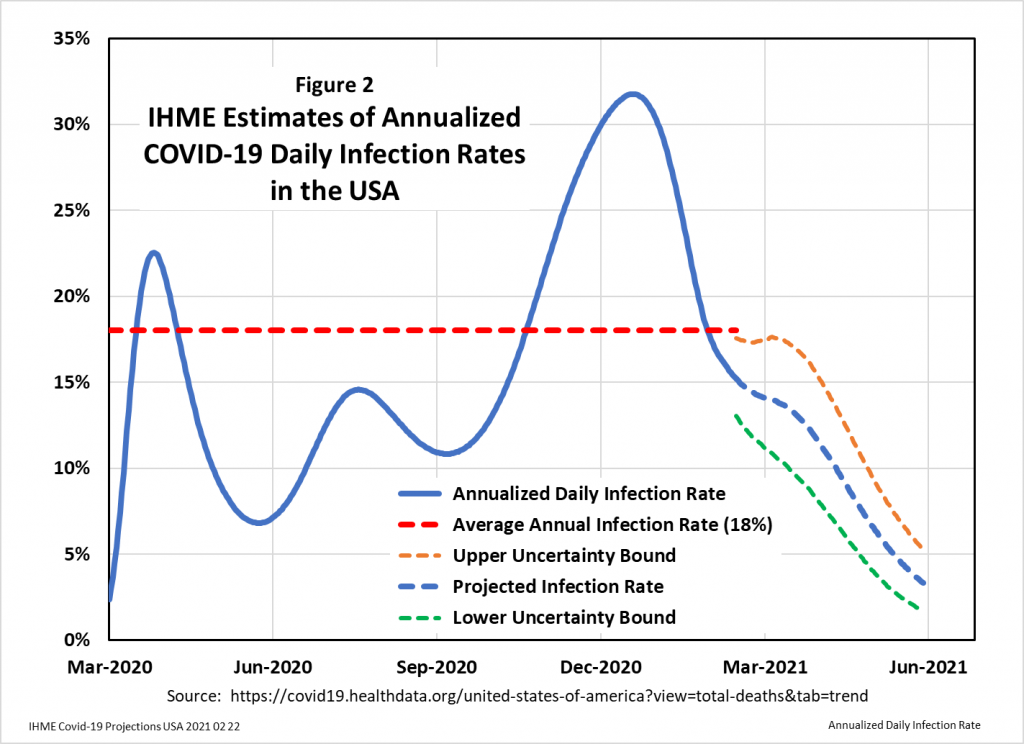
The implication of the IHME projection is that, by May 2021, the ACIR will drop below 5%. Thanks to the end of the virus season and the onset of herd immunity, the average American will face an annual risk of contracting COVID-19 of less than one-in-twenty. An individual American will be at higher or lower risk depending upon his relative exposure to infected subjects.
Nevertheless, COVID-19 will remain dangerous for people susceptible to the severe acute respiratory syndrome which can result in hospitalization and death. This danger is reflected in the COVID-19 Infection Fatality Rate (CIFR), which is a measure of the percentage of subjects infected with SARS-CoV-2 who die because of the infection.
Worth reading in full.
Stop Press: Eleanor Hayward in the Daily Mail has reported the startling statistic that one in four of the deaths attributed to Covid were of people with dementia, highlighting the huge skew towards those in care homes, as well as the devastating toll of isolation.
More than 34,000 dementia sufferers have died from COVID-19, research published today shows.
One in four of all virus deaths have been among those with the illness – but care home visiting bans have denied families the chance to say goodbye.
Today’s study lays bare the devastating toll of lockdown on the nation’s 850,000 care home residents living with dementia.
Nine in 10 families said the pandemic had accelerated their loved one’s symptoms, the Alzheimer’s Society found.
Seven in 10 care home residents have dementia, but most have not had meaningful visits for almost a year.
Almost a quarter of family members have not been able to see their relative with dementia at all for over six months, the survey reveals. This isolation and loneliness has caused some residents to lose the ability to eat, drink and speak.
More than a quarter of family members who care for someone with dementia said they witnessed an “unmanageable decline” in the health of their relative.
Of the 124,978 COVID-19 deaths registered up to February 12th, an estimated 27.5% had dementia.
Worth reading in full.
Government’s Notorious ‘1 in 3’ Propaganda Line Doesn’t Square With ONS Data
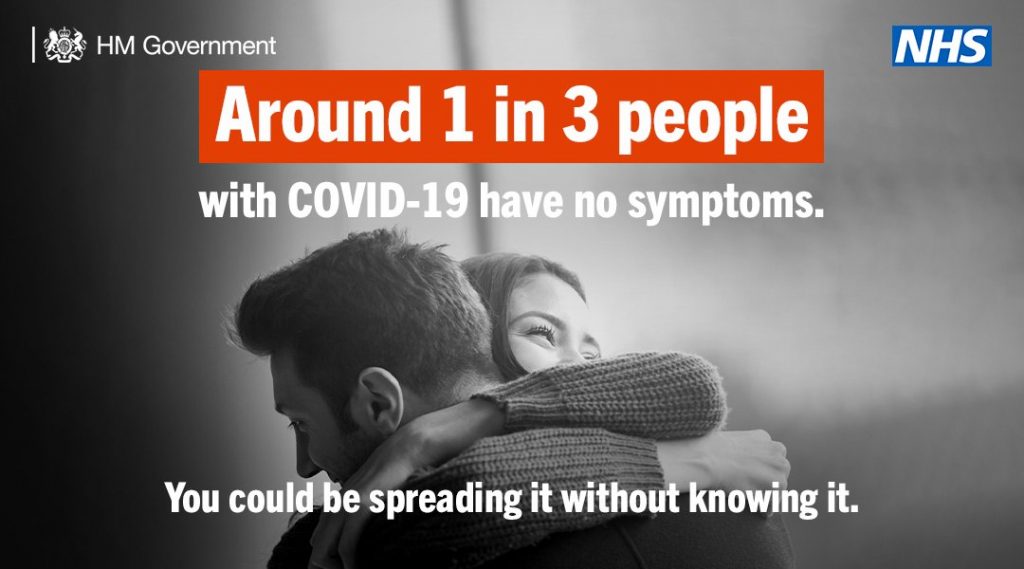
Norman Fenton, a Professor of Risk Information Management at Queen Mary University has analysed the data from a study of ‘asymptomatic cases’ in Cambridge and published his conclusions in a blog post:
The Cambridge study testing asymptomatics is the gift that keeps on giving…
This makes interesting reading for anybody who still believes the Government ‘case’ data and the claim that just because you don’t have any COVID-19 symptoms it doesn’t mean you aren’t an danger.
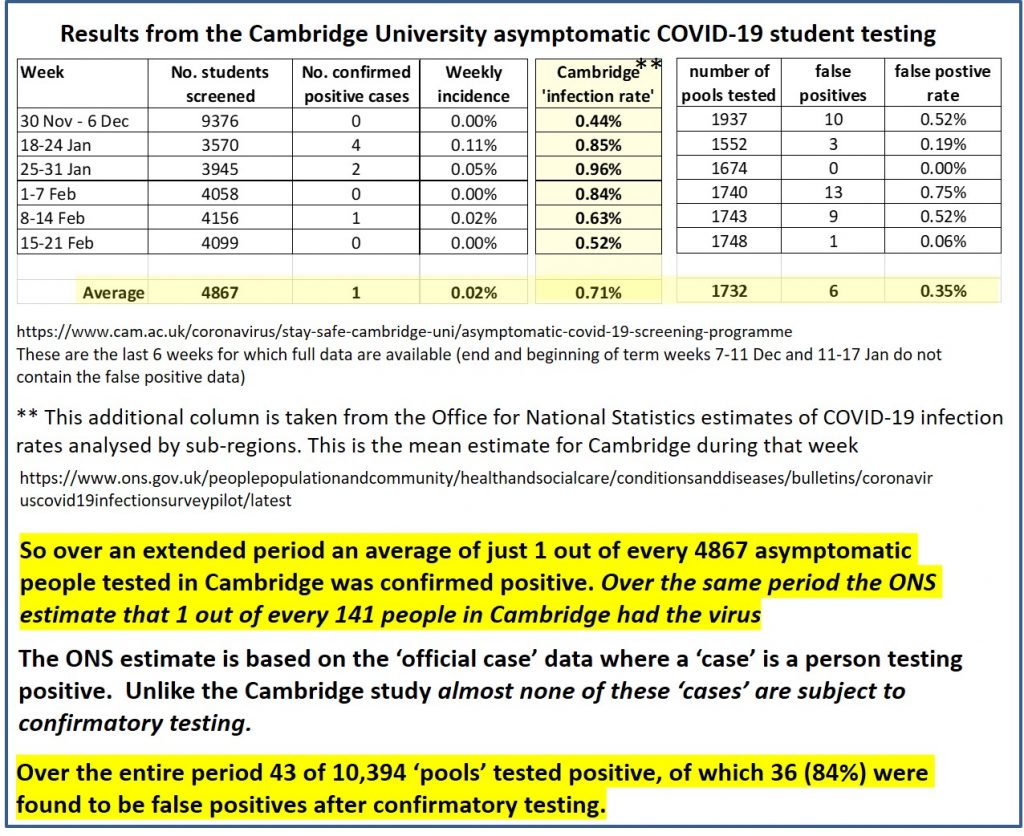
This data also means that if the Government claim that “1 in 3 people with the virus has no symptoms” is correct then the ONS estimated infection rate is massively inflated – the currently reported ‘case’ numbers must be at least 8 times greater than the true number of cases. On the other hand, if the Government estimates of case numbers are correct then at most 1 in 26 people with the virus has no symptoms. Here’s an informal explanation why (formal proof is below):
Cambridge has a population of 129,000.
If the ONS infection estimates for Cambridge (0.71%) are accurate, then during an average week in this period about 916 people had the virus and 128,084 did not.
But if the “1 in 3” claim is correct about 305 people in Cambridge had the virus but no symptoms.
So at most 128,389 people in Cambridge had no symptoms and that means at least 305/128389 people with no symptoms had the virus. That is at least 0.24% (i.e. at least around 1 in 421).
But the study shows on average only 1 in 4867 (0.028%) with no symptoms had the virus. So there should only have been about 36.
That means the “1 in 3” claim and the ONS estimates cannot both be correct.
If the “1 in 3” claim is correct, then the maximum possible value for the infection rate is 0.084% and not 0.71% as claimed (with 0.084% we would have 108 with the virus of whom 36 have no symptoms). So the ONS estimated infection rate is over eight times greater than the true rate.
If the 0.71% infection rate is correct, then the maximum possible value for the proportion of people with the virus who have no symptoms is 3.9% (as this would mean 36 of the 916 people with the virus have no symptoms as predicted by the Cambridge data).
Worth reading Professor Fenton’s conclusions and workings out in full.
“Why I am Not a Lockdown Sceptic”

We are publishing on original piece today by Alastair Cavendish, a former professor of English Literature, explaining why technically speaking he is not a sceptic. Below is an extract:
In times of stress, which occur with increasing frequency these days, I find myself turning to Lockdown Sceptics almost as a guilty pleasure. One ought, of course, to challenge oneself with news sources that do not simply reflect one’s own views. The echo chamber and the hall of mirrors have become characteristic metaphors to describe the news media, which produce sounds and images as distorted as they are familiar. On Lockdown Sceptics, however, I can at least be certain of finding sanity, courtesy, and commitment to evidence, qualities which are in short supply elsewhere. The alternatives are to retreat even further from human society, or to listen to a smug voice on the BBC wondering out loud how people like Toby Young can sleep at night with all the blood on their hands.
All the same, I am not a lockdown sceptic myself, any more than I am a racism sceptic or a rape sceptic. Lockdown, like racism and rape, is an evil thing, and I am unequivocally against it. If this seems like an extremist position, consider the question as a variant of the trolley problem, which has been a staple of philosophy classrooms since Judith Jarvis Thompson and Philippa Foot wrote about it in the 1970s. The student is asked to imagine that s/he is a bystander who is watching a trolley speeding along a track, on which there are five people tied up ahead. There is no way to stop the trolley, but it is possible to pull a lever which will divert it onto another track, on which there is one person tied up.
Many people say that they would pull the lever and murder the person on the other track. However, they are apt to change their mind when presented with an alternative problem in which the bystander is on a bridge, standing beside a large, heavy man. The trolley is about to run under the bridge, but the man is large enough to stop the trolley if he is pushed onto the track, though it will kill him in the process. Very few people say that they would push the man onto the track, killing him in order to save the five people tied up ahead.
The parallel with lockdown is clear. Lockdowns kill people, and the people who will suffer most from them are reasonably foreseeable. Those who live alone, and whose mental health is fragile, are clearly suicide risks. So are people who have lost their businesses and livelihoods, or jobs that gave their life meaning. Many others are at risk from untreated conditions less fashionable than COVID-19. To be in favour of lockdown is to say that these people are less valuable than others, the type of people one might as well shove off a bridge to stop a speeding trolley.
Worth reading in full.
A Change in Nomenclature

A reader has written in with a suggestion, along with a doctored photo to illustrate his point.
‘Pro-lockdowner’ is a bit of a mouthful. Why not ‘Morlock’, after the sinister underground creatures of HG Wells’s Time Machine?
COVID-1984

We have a particularly good crop of ‘Party Slogans’ submitted by readers today:
REASON IS TREASON
‘THE SCIENCE’ IS SCIENCE
DATASET IS TRUTH
TRUTH IS LOCKDOWN
SOCIALISING IS SELFISH
INACTIVITY IS HEALTH
FRESH AIR IS CONTAGION
EXERCISE IS UNHEALTHY
HUGGING IS VIOLENCE
SICKNESS IS SELFISH: HEALTHCARE MUST BE LIBERATED FROM SELFISHNESS
and…
VARIANTS BYPASS COMMUNITY IMMUNITY WITH IMPUNITY
Do keep them coming – send them to us here.
Poetry Corner
A reader, a man of the cloth, has sent us a ‘Covid-Tide Hymn for Supine Clergy’ to be sung to the tune of “All to Jesus” by Winfield Scott Weeden:
1.
All to Boris I surrender,
All to SAGE I freely give,
I will ever live and trust them
In their presence daily live.
Chorus:
I surrender all,
I surrender all,
All to thee my glorious leaders,
I surrender all.
2.
All to Boris I surrender,
Humbly at his feet I bow,
Worldly pleasures all got taken;
Lock me, Boris, lock me down.
(Chorus)
3.
All to Boris I surrender,
Take my freedom, it’s all thine;
Let me have thy saving vaccine,
Truly know that this is fine.
(Chorus)
4.
All to Boris I surrender,
Now I feel the sacred jab.
Oh, the joy of full salvation!
Glory, I can use a cab!
(Chorus)
Round-up
- “Lockdowns have killed millions” – Swedish doctor Sebastian Rushworth reiterating the recent conclusions of the Karolinska Institutet in his country
- “Nasty Nick incites pro-vax ‘lynch mob‘” – Nick Cohen has written an unpleasant column in the Observer hinting at impending conflict between what he sees as the sensible jabbed majority and the deluded fringe who refuse. Niall McCrae in Unity News Network is unimpressed
- “Spit for freedom” – Jonathan Saxty in the Critic wonders whether a new kind of test could save a lot of hassle
- “Government and little people: the democratic divide in Danandrewstan” – Cian Hussey of the Institute of Public Affairs writes in the Spectator Australia of the problem of the sheltered elites vs the poor saps that have to suffer the consequences of their decisions in Victoria, governed by surely one of the most draconian leaders in the Anglosphere, Dan Andrews
- “Heil the vaccine apartheid!” – Provocative piece by Laura Perrins in Conservative Woman
- “The number of children in care has increased during the pandemic” – Harry Phibbs at Conservative Home with news of yet more collateral damage suffered by the young
- “Experts call Peel guidelines to place children in solitary quarantine ‘cruel punishment’” – The Toronto Sun reports that even in Canada there are experts who think public health advice can be a bit OTT, after advice was given to totally isolate children at home apart from their own families if one of their classmates had tested positive
- “Inside the race to create a vaccine passport” – Steve Boggan in UnHerd with an (uncritical) article about the various cogs whirring into motion to get vaccine passports running smoothly
- “Growing trend in the US of ‘double masking’ prompts Government scientists to consider updating latest advice” – Telegraph reporting that PHE is going to ‘follow the science’ and recommend triple-masking here too
- “End the lockdown on protest” – Tom Slater in spiked on the fight for civil liberties after Priti Patel threatened to extend emergency anti-protesting laws
- “Screw the sex ban” – Also in spiked, Emily Hill reckons there isn’t time to waste in the search for love
- “Substantial meal policy may have discriminated against BAME customers in pubs, High Court rules” – Ewan Somerville in the Telegraph on one of the many problems with the now scrapped ‘Scotch Egg Rule’
- RAF Luton posted a tweet earlier about their efforts to enforce social distancing rules. Thankfully, no such air force base exists.
Theme Tunes Suggested by Readers
Eight today: “Life is for Living” by the Malopoets, “Chaos is my Life” by The Exploited, “Do Nothing” by The Specials, “Take Back the Land” by Oi Polloi, “You’ve Got a Lot to Answer For” by Catatonia, “Shake the Disease” by Depeche Mode, “Clock is Running ” by Seasick Steve and “The Revolution Will Not Be Televised” by Gill Scott Heron.
Love in the Time of Covid

We have created some Lockdown Sceptics Forums, including a dating forum called “Love in a Covid Climate” that has attracted a bit of attention. We have a team of moderators in place to remove spam and deal with the trolls, but sometimes it takes a little while so please bear with us. You have to register to use the Forums as well as post comments below the line, but that should just be a one-time thing. Any problems, email Lockdown Sceptics here.
Sharing Stories
Some of you have asked how to link to particular stories on Lockdown Sceptics so you can share it. To do that, click on the headline of a particular story and a link symbol will appear on the right-hand side of the headline. Click on the link and the URL of your page will switch to the URL of that particular story. You can then copy that URL and either email it to your friends or post it on social media. Please do share the stories.
Social Media Accounts
You can follow Lockdown Sceptics on our social media accounts which are updated throughout the day. To follow us on Facebook, click here; to follow us on Twitter, click here; to follow us on Instagram, click here; to follow us on Parler, click here; and to follow us on MeWe, click here.
Woke Gobbledegook

We’ve decided to create a permanent slot down here for woke gobbledegook. Today, we have an extract from “There is No Such Thing as White Math”, in which Princeton mathematics Professor Sergiu Klainerman laments how even STEM subjects have begun to succumb to woke gobbledegook.
Like children all over the world, I was attracted to mathematics because of its formal beauty, the elegance and precision of its arguments, and the unique sense of achievement I was able to get by finding the right answer to a difficult problem. Mathematics also granted me an escape from the intoxicating daily drum of party propaganda – a refuge from the crushing atmosphere of political and ideological conformity.
The woke ideology, on the other hand, treats both science and mathematics as social constructs and condemns the way they are practiced, in research and teaching, as manifestations of white supremacy, euro-centrism, and post-colonialism.
Take for example the recent educational program called “A pathway to equitable math instruction”. The program is backed financially by the Bill and Melinda Gates Foundation; it counts among its partners the Lawrence Hall of Science at U.C. Berkeley, the California Math project, the Association of California School Administrators, and the Los Angeles County Office of Education, among others; and it was recently sent to Oregon teachers by the state’s Department of Education.
The program argues that “white supremacy culture shows up in the classroom when the focus is on getting the ‘right’ answer” or when students are required to show their work, while stipulating that the very “concept of mathematics being purely objective is unequivocally false”. The main goal of the program is “to dismantle racism in mathematics instruction” with the expressly political aim of engaging “the sociopolitical turn in all aspects of education, including mathematics”.
In the past, I would have said that such statements should be ignored as too radical and absurd to merit refutation. But recent trends across the country suggest that we no longer have that luxury.
So let me state the following for the record: Nothing in the history and current practice of mathematics justifies the notion that it is in any way different or dependent on the particular race or ethnic group engaged in it.
For historical reasons, we often discuss contributions to the field of mathematics from the Egyptians, Babylonians, Greeks, Chinese, Indians and Arabs and refer to them as distinct entities. They have all contributed through a unique cultural dialogue to the creation of a truly magnificent edifice accessible today to every man and woman on the planet. Though we pay tribute to great historical figures who inform the practice of mathematics, the subject can be taught – and often is – with no reference to the individuals who have contributed to it. In that sense it is uniquely universal.
Schools throughout the world teach the same basic body of mathematics. They differ only by the methodology and intensity with which they instruct students.
It is precisely this universality of math – together with the extraordinary ability of American universities to reward hard work and talent – that allowed me, and so many other young scientists and mathematicians, to come to this country and achieve success beyond our wildest dreams.
The idea that focusing on getting the “right answer” is now considered among some self-described progressives a form of bias or racism is offensive and extraordinarily dangerous. The entire study of mathematics is based on clearly formulated definitions and statements of fact. If this were not so, bridges would collapse, planes would fall from the sky, and bank transactions would be impossible.
Worth reading in full.
Stop Press: Sir Kazuo Ishiguro says that young writers may be self-censoring to avoid the ire of woke mobs. The BBC has more.
Sir Kazuo, who won the Nobel Prize in Literature in 2017, warned that a “climate of fear” was preventing some people from writing what they want.
He said they may be concerned that an “anonymous lynch mob will turn up online and make their lives a misery”.
He told the BBC: “I very much fear for the younger generation of writers.”
The 66-year-old said he was worried that less established authors were self-censoring by avoiding writing from certain viewpoints or including characters outside their immediate experiences.
“I think that is a dangerous state of affairs,” added the acclaimed author, whose works include The Remains of the Day and Never Let Me Go.
He said he was particularly troubled about young writers “who rightly perhaps feel that their careers are more fragile, their reputations are more fragile and they don’t want to take risks”.
His comments come after a number of freedom of speech disputes, with writers being “cancelled” or facing threats to boycott their work. High-profile targets have included J.K. Rowling, Julie Burchill and Jeanine Cummins.
Sir Kazuo, however, who received a knighthood in 2019, said he was not worried about being “cancelled”.
“I think I’m in a privileged and relatively protected position because I’m a very established author,” he said. “I’m the age I am. I have a reputation. Perhaps it’s an illusion but I think I’m protected.”
Worth reading in full.
“Mask Exempt” Lanyards
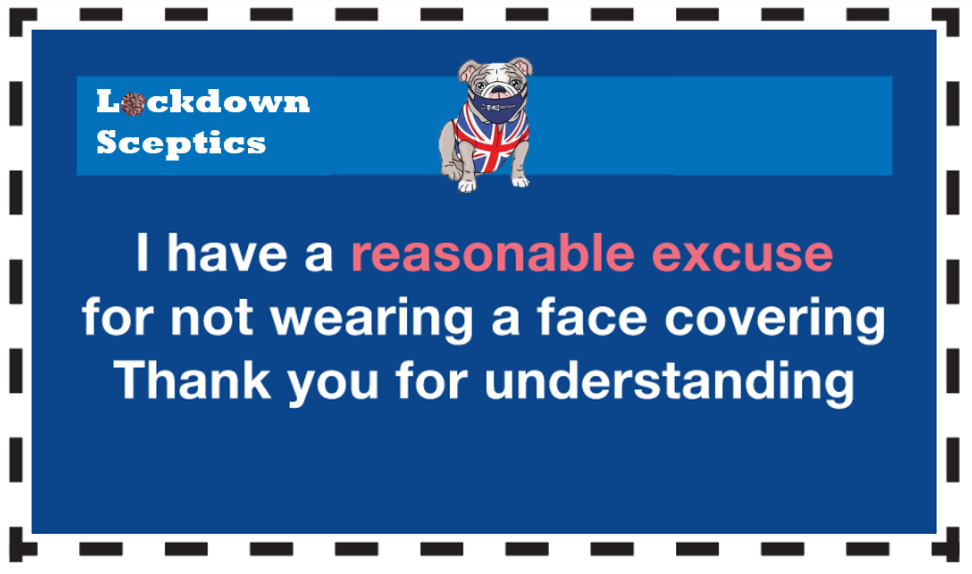
We’ve created a one-stop shop down here for people who want to obtain a “Mask Exempt” lanyard/card – because wearing a mask causes them “severe distress”, for instance. You can print out and laminate a fairly standard one for free here and the Government has instructions on how to download an official “Mask Exempt” notice to put on your phone here. And if you feel obliged to wear a mask but want to signal your disapproval of having to do so, you can get a “sexy world” mask with the Swedish flag on it here.
A reader has started a website that contains some useful guidance about how you can claim legal exemption. Another reader has created an Android app which displays “I am exempt from wearing a face mask” on your phone. Only 99p.
If you’re a shop owner and you want to let your customers know you will not be insisting on face masks or asking them what their reasons for exemption are, you can download a friendly sign to stick in your window here.
And here’s an excellent piece about the ineffectiveness of masks by a Roger W. Koops, who has a doctorate in organic chemistry. See also the Swiss Doctor’s thorough review of the scientific evidence here and Prof Carl Heneghan and Dr Tom Jefferson’s Spectator article about the Danish mask study here.
The Great Barrington Declaration

The Great Barrington Declaration, a petition started by Professor Martin Kulldorff, Professor Sunetra Gupta and Professor Jay Bhattacharya calling for a strategy of “Focused Protection” (protect the elderly and the vulnerable and let everyone else get on with life), was launched in October and the lockdown zealots have been doing their best to discredit it ever since. If you googled it a week after launch, the top hits were three smear pieces from the Guardian, including: “Herd immunity letter signed by fake experts including ‘Dr Johnny Bananas’.” (Freddie Sayers at UnHerd warned us about this the day before it appeared.) On the bright side, Google UK has stopped shadow banning it, so the actual Declaration now tops the search results – and Toby’s Spectator piece about the attempt to suppress it is among the top hits – although discussion of it has been censored by Reddit. In February, Facebook deleted the GBD’s page because it “goes against our community standards”. The reason the zealots hate it, of course, is that it gives the lie to their claim that “the science” only supports their strategy. These three scientists are every bit as eminent – more eminent – than the pro-lockdown fanatics so expect no let up in the attacks. (Wikipedia has also done a smear job.)
You can find it here. Please sign it. Now over three quarters of a million signatures.
Update: The authors of the GBD have expanded the FAQs to deal with some of the arguments and smears that have been made against their proposal. Worth reading in full.
Update 2: Many of the signatories of the Great Barrington Declaration are involved with new UK anti-lockdown campaign Recovery. Find out more and join here.
Update 3: You can watch Sunetra Gupta set out the case for “Focused Protection” here and Jay Bhattacharya make it here.
Update 4: The three GBD authors plus Prof Carl Heneghan of CEBM have launched a new website collateralglobal.org, “a global repository for research into the collateral effects of the COVID-19 lockdown measures”. Follow Collateral Global on Twitter here. Sign up to the newsletter here.
Judicial Reviews Against the Government

There are now so many legal cases being brought against the Government and its ministers we thought we’d include them all in one place down here.
The Simon Dolan case has now reached the end of the road. The current lead case is the Robin Tilbrook case which challenges whether the Lockdown Regulations are constitutional, although that case, too, has been refused permission to proceed. There’s still one more thing that can be tried. You can read about that and contribute here.
The GoodLawProject and three MPs – Debbie Abrahams, Caroline Lucas and Layla Moran – brought a Judicial Review against Matt Hancock for failing to publish details of lucrative contracts awarded by his department and it was upheld. The Court ruled Hancock had acted unlawfully.
Then there’s John’s Campaign which is focused specifically on care homes. Find out more about that here.
There’s the GoodLawProject and Runnymede Trust’s Judicial Review of the Government’s award of lucrative PPE contracts to various private companies. You can find out more about that here and contribute to the crowdfunder here.
Scottish Church leaders from a range of Christian denominations have launched legal action, supported by the Christian Legal Centre against the Scottish Government’s attempt to close churches in Scotland for the first time since the the Stuart kings in the 17th century. The church leaders emphasised it is a disproportionate step, and one which has serious implications for freedom of religion.” Further information available here.
There’s the class action lawsuit being brought by Dr Reiner Fuellmich and his team in various countries against “the manufacturers and sellers of the defective product, PCR tests”. Dr Fuellmich explains the lawsuit in this video. Dr Fuellmich has also served cease and desist papers on Professor Christian Drosten, co-author of the Corman-Drosten paper which was the first and WHO-recommended PCR protocol for detection of SARS-CoV-2. That paper, which was pivotal to the roll out of mass PCR testing, was submitted to the journal Eurosurveillance on January 21st and accepted following peer review on January 22nd. The paper has been critically reviewed here by Pieter Borger and colleagues, who also submitted a retraction request, which was rejected in February.
And last but not least there was the Free Speech Union‘s challenge to Ofcom over its ‘coronavirus guidance’. A High Court judge refused permission for the FSU’s judicial review on December 9th and the FSU has decided not to appeal the decision because Ofcom has conceded most of the points it was making. Check here for details.
Samaritans

If you are struggling to cope, please call Samaritans for free on 116 123 (UK and ROI), email jo@samaritans.org or visit the Samaritans website to find details of your nearest branch. Samaritans is available round the clock, every single day of the year, providing a safe place for anyone struggling to cope, whoever they are, however they feel, whatever life has done to them.
Shameless Begging Bit
Thanks as always to those of you who made a donation in the past 24 hours to pay for the upkeep of this site. Doing these daily updates is hard work (although we have help from lots of people, mainly in the form of readers sending us stories and links). If you feel like donating, please click here. And if you want to flag up any stories or links we should include in future updates, email us here. (Don’t assume we’ll pick them up in the comments.)
And Finally…

Toby and James Delingpole have recorded their weekly episode of London Calling. In this edition, they discuss Peter Hitchens’s decision to have the jab – he and James were going at it like rats in a sack on Twitter yesterday – as well as Harry and Meghan’s upcoming moan fest, Toby’s career advice to James Corden (delivered in person at the GQ Man of the Year awards) and the novels of Bernard Cornwell.
You can listen to the episode here and subscribe to the podcast here.










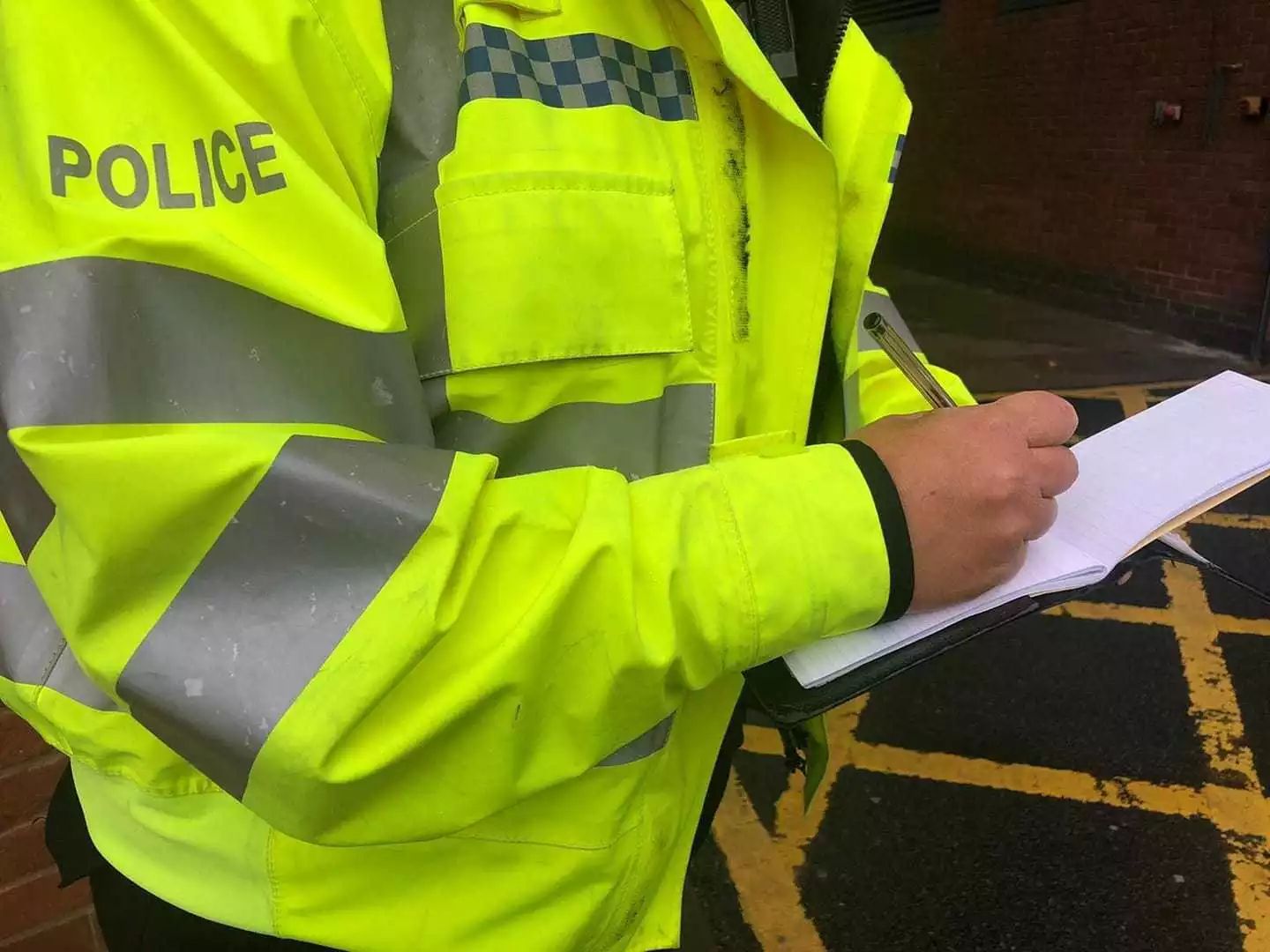


To join in with the discussion please make a donation to The Daily Sceptic.
Profanity and abuse will be removed and may lead to a permanent ban.